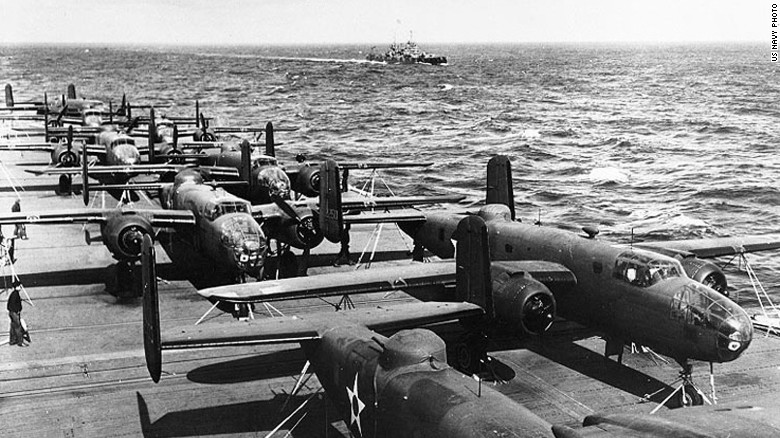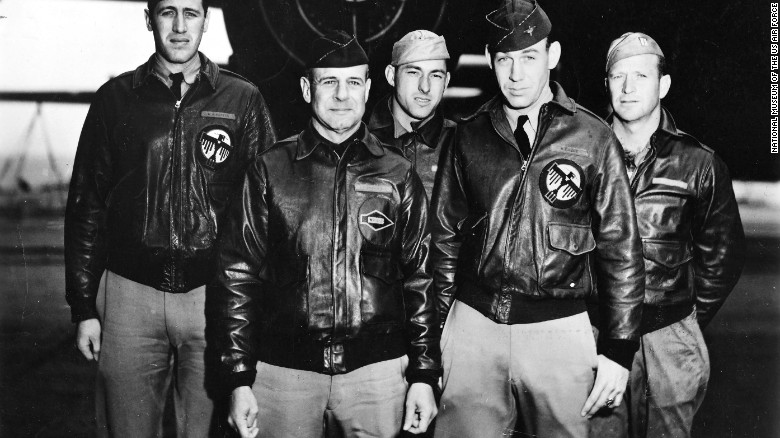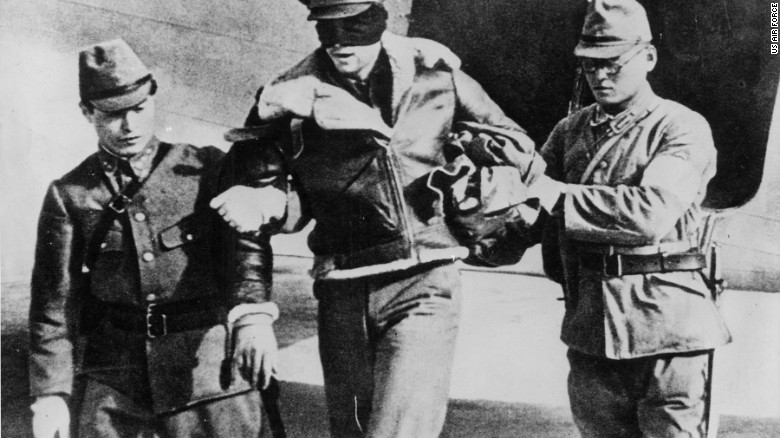- Goose
- Cogito ergo sum
 Offline
Offline 
- Registered: 1/29/2015
- Posts: 13,427
Last living Doolittle Raider recalls America's revenge attack
Last living Doolittle Raider recalls America's revenge attack
(CNN)When vintage World War II bombers known as B-25 Mitchells thrill fans on the US airshow circuit, they honor the legacy of one of the most daring military missions in American history.
At Georgia's Perry-Houston County Airport on Friday a B-25 named Show Me sat at the end of Runway 36. Its powerful propeller twin engines shook the seats as the bomber waited to takeoff -- a little bit like Jimmy Doolittle and his raiders did in 1942 aboard the USS Hornet.
Eighty men volunteered for that mission -- what turned out to be a one-way air attack -- vengeance for Japan's strike on Hawaii that crippled the US Navy fleet and left 2,403 dead.
For them, Pearl Harbor was their 9/11.
After four months, it was time for payback.
The mission -- depicted in the 2001 film "Pearl Harbor" -- called for 16 US B-25s to take off from an aircraft carrier near Japan. The planes would bomb five Japanese cities and fly on to China, where the men would connect with friendly forces who would help them get home.
Climb aboard a B-25 Mitchell
On April 18, 1942, Doolittle and co-pilot Richard E. "Dick" Cole sat in the cockpit of their B-25 going over a preflight check list with the engines running.
"I was setting the engine cowl flaps and watching to make sure the engines didn't overheat," said Cole, now 101 years old and a retired Air Force lieutenant colonel.
"It was a bit hectic," he said, because crews were scrambling. The mission launch was moved up by 12 hours because of fears that Tokyo had been tipped off.
As a result, the B-25s would have to take off hundreds of miles farther from Japan than planned. That meant the planes wouldn't have enough fuel to guarantee they'd land safely in China.
"We were the first plane," Cole said. "I remember I was hoping that we had done everything that we needed to do to make the takeoff. "
A versatile airplane
Aboard our Friday B-25 flight in Georgia, Show Me's pilot, Craig O'Mara, kept his feet on the brakes while pushing the throttles forward — revving up the ridiculously loud engines.
"The noise is intense," said David Thompsen, another Show Me pilot, because engine exhaust pipes aim toward the cockpit and crew cabin.
With a green light from air traffic controllers, O'Mara released the brake and unleashed the aircraft.
The 72-year-old plane raced 2,000 to 2,500 feet down the runway, accelerating to about 120 mph before completely leaving the ground.
Owned by the Commemorative Air Force, Show Me appears at airshows nationwide to promote the Disabled American Veterans, a nonprofit charity which helps give a voice to disabled US vets returning from war. This weekend, the plane is one of the stars of the Thunder Over Georgia airshow at nearby Robins Air Force Base.
During its heyday, the B-25 was a respectable warplane -- distinguished by its twin-tail and versatility. "It became the most heavily armed airplane in the world, was used for high- and low-level bombing, strafing, photoreconnaissance, submarine patrol, and even as a fighter," according to Boeing.
Of nearly 10,000 B-25s built by North American Aviation, Show Me (which was not on the Doolittle Raid) is among fewer than 50 that can still fly.
From our Georgia airport, it's about 300 miles to Eglin Air Force Base in Florida, where Doolittle's raiders trained in secret seven decades ago to learn cross-country navigation without radios or landmarks and how to execute short takeoffs from ships.
"The highest risk for pilots during takeoff from a carrier would have been an engine failure at a slow speed," Thompsen said. Engine failure would force pilots to abort takeoff. They risked losing control of the plane which could allow it to veer into key structures on the ship.
The mission begins
A typical B-25 takeoff uses about 2,000 feet of runway, Thompsen said. But the Hornet's deck allowed the planes as little as 300 feet to get airborne — otherwise they'd drop off the edge and crash into the ocean.
Amazingly, the mission pilots had been trained to be able to take off as slowly as 75 mph with as little as 250 feet of runway.
Have pilots ever tried that with Show Me? "No we haven't," Thompsen said. "That's a high-risk maneuver and we don't do that. We try to treat her gently."
With the natural winds, combined with speed from the moving ship, the B-25s only needed to get up to about 23 mph to fly off the Hornet, Cole said. Japan was about 650 miles away.
A flag on the deck green-lighted the takeoff. It was time.
Both Cole and Doolittle kept their hands on the engine throttles to make sure the levers didn't accidentally slip downward and -- in case of engine failure -- to quickly bring the plane to a stop.
With his engines revving hard, Doolittle released the brakes, sending the plane barreling toward the ship's edge.
Seconds later, the first raiders were airborne.
'A little bit scary'
They made one circle over the Hornet and then pointed the airplane toward Japan. Soon, all 15 remaining planes followed. The grueling mission had begun.
"I remember thinking we had just separated ourselves from civilization," Cole said. "The range of our short-wave radio was only about 45 miles and we were going to be more than 45 miles away from civilization for 8 or 10 hours."
"In a way it was a little bit scary," he said. But they were fully committed. There was no turning back.
Doolittle's crew: From left: navigator Henry "Hank" Potter, pilot James "Jimmy" Doolittle, bombardier Fred Braemer, co-pilot Richard "Dick" Cole, engineer/gunner Paul Leonard
To avoid detection, the raiders flew extremely close to the Pacific — sometimes dangerously low.
At speeds around 190 mph, Doolittle flew about 200 feet above the water. Incredibly, some pilots flew as low as 50 feet. One stiff wind or mistake in the cockpit could've sent the 14-ton bombers crashing into the ocean.
'Drop the bombs'
At about noon, Doolittle and Cole's crew were the first of the raiders to reach Tokyo. Still flying low, they encountered no air attacks, Cole said. Apparently, the element of surprise was intact.
Bombardier Fred Braemer found a target and "Col. Doolittle pulled up to 1,500 feet and said, 'Drop the bombs,'" Cole recalled. At one point over Tokyo Cole spotted several Japanese aircraft high above. "Apparently they did not see us," he said.
The B-25's bomb bay is pretty much completely enclosed. "The bomb bay doors are hydraulically operated and they move very fast," Thompsen said. "When they close, they're kind of like a guillotine."
Overall, the raiders' 16 planes hit factory areas, oil storage facilities and military installations.
Despite plenty of anti-aircraft fire from the ground, all the planes reached their targets without being shot down.
The raiders had accomplished their mission. They disproved Japan's claims that the mainland was impervious to enemy attack.
They also had dealt America's first blow in response to Pearl Harbor -- raising morale back home.
"I felt that we made a pretty good retaliatory strike," Cole said.
Jumping out of a plane in the dark during a storm
But the mission was far from over. They still had to get home -- via China.
When Doolittle and Cole's plane reached the Chinese coast they were running low on fuel.
Worse, it was dark and they were surrounded by a powerful storm. With no safe landing zone in sight, Doolittle ordered his crew to bail out at 9,000 feet, traveling about 166 mph.
"All kinds of ideas go through your head" before you jump out of an airplane into the dark during a thunderstorm," Cole said.
"Number one, you hoped that the 'chute would work and number two, you hoped you'd have a sense to know what you were going to hit in the terrain below you when you bailed out."
"Fortunately for me, I didn't have to worry about hitting the ground," he said. "My 'chute opened fine and it caught on a small pine tree which made my landing very easy."
Cole spent the night in his parachute, suspended about 10 feet off the ground. The next day he met up with friendly Chinese Nationalist troops who also found Doolittle and the rest of the crew. A few days later they all were escorted to a US military aircraft, which flew them to safety.
The legacy
Overall, 11 crews bailed out of their bombers. Four planes crash-landed. One crew flew to the Soviet Union. Of the 80 raiders, three were killed in action. Eight were captured; one starved to death in a Japanese prison camp and three were executed.
As if they hadn't done enough, after recovering from their mission, many raiders, including Cole, rejoined the war to fight again.
After the war, the surviving raiders lived out the rest of their lives, pursuing careers, building families, enjoying their children, grandchildren and great-grandchildren.
The survivors would reunite to toast their victory and their comrades.
Two weeks ago the Air Force honored the mission's legacy by naming its new long-range B-21 bomber The Raider, which is expected fly as soon as the mid-20s.
Last June, former B-25 gunner/engineer David Thatcher died at age 94, making Cole the last living raider.
When you can look back on a life like Cole's, you've likely learned a few lessons along the way. The man who helped lead the Doolittle raiders offered some advice.
"As you go through life," Cole said, "expect the unexpected."
Last edited by Goose (10/01/2016 6:29 am)
We live in a time in which decent and otherwise sensible people are surrendering too easily to the hectoring of morons or extremists.
 1 of 1
1 of 1